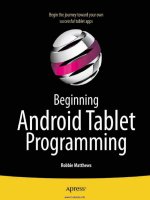Reactive android programming
Bạn đang xem bản rút gọn của tài liệu. Xem và tải ngay bản đầy đủ của tài liệu tại đây (4.3 MB, 372 trang )
Title Page
Reactive Android Programming
Learn to build Android application using RxJava
Tadas Subonis
BIRMINGHAM - MUMBAI
Copyright
Reactive Android Programming
Copyright © 2017 Packt Publishing
All rights reserved. No part of this book may be reproduced, stored in a
retrieval system, or transmitted in any form or by any means, without the
prior written permission of the publisher, except in the case of brief
quotations embedded in critical articles or reviews.
Every effort has been made in the preparation of this book to ensure the
accuracy of the information presented. However, the information contained in
this book is sold without warranty, either express or implied. Neither the
author, nor Packt Publishing, and its dealers and distributors will be held
liable for any damages caused or alleged to be caused directly or indirectly by
this book.
Packt Publishing has endeavored to provide trademark information about all
of the companies and products mentioned in this book by the appropriate use
of capitals. However, Packt Publishing cannot guarantee the accuracy of this
information.
First published: May 2017
Production reference: 1240517
Published by Packt Publishing Ltd.
Livery Place
35 Livery Street
Birmingham
B3 2PB, UK.
ISBN 978-1-78728-990-1
www.packtpub.com
This book was downloaded from AvaxHome!
Visit my blog for more new books:
/>
Credits
Author
Copy Editor
Tadas Subonis
Shaila Kusanale
Reviewers
Mantas Aleknavicius
Project Coordinator
Javier Gamarra
Ritika Manoj
SeongUg Jung
Commissioning Editor
Proofreader
Amarabha Banerjee
Safis Editing
Acquisition Editor
Indexer
Siddharth Mandal
Mariammal Chettiyar
Content Development Editor
Graphics
Mohammed Yusuf Imaratwale
Jason Monteiro
Technical Editor
Production Coordinator
Rashil Shah
Melwyn Dsa
About the Author
Tadas Subonis started coding roughly when he was thirteen. Since then, he
has programmed with PHP, JavaScript, Python, C++, and Java (the language
in which he has probably written the most code). He took up Android
relatively recently--around 2014 (after a few false starts in 2012).
However, he soon learned that Android lacks decent support for
asynchronous programming (Async Task was/is a joke) while more reckless
languages, such as JavaScript, had Promises for a long time. Furthermore,
Java's standard library was lacking decent support for functional
programming primitives (map, filter), but that was easily fixable with
libraries such as Guava.
This led Tadas to search for a library that would help him achieve a Promiselike functionality and interface. It didn't take long until he found ReactiveX
and its family of implementations (including RxJava) that handle streams in
Reactive fashion. It wasn't exactly the flow of Promise-like systems but, soon
enough, he realized that it's something even more powerful.
Since then, he has been using RxJava (and RxKotlin) for his daily Android
programming. The quality of the code (the lack of bugs, readability, and
maintainability) has improved ten-fold. Giving a quick crash-free experience
for the users of your application is a must these days when competition for
user attention on app marketplaces is getting fiercer and fiercer.
First of all, I would like to thank Packt for the opportunity to write this book.
Also, I would like to thank their editorial team for the amazing support they
gave me while working on this book. Finally, I would like to thank my
significant other, Aušrinė, who had the patience to endure my unavailable
evenings while I was working on this book.
About the Reviewers
Javier Gamarra is a developer who's always eager to learn and improve.
He currently works as an Android developer at Liferay, and he has worked
with many development stacks: JS (Angular, Node…), Java EE, Scala, and
Python. He loves challenges and learning about data visualization.
In his spare time, he organizes conferences and meetups in @cylicon_valley, a
tech meetup in Castilla y Leon to help spread better technical practices in
other companies, and he's a member of the board of @agilespain, the Spanish
Agile national association.
He is available everywhere on the Internet under the @nhpatt handle.
Thanks Bea for always being there!
SeongUg Jung has been developing Android applications for consumers and
enterprises since 2010. He started his career working at Daou Tech,
developing various applications such as messenger, calendar, e-mail, and
Mobile Application Management services (including web). In December
2014, he became the lead Android Developer at Toss Lab, Inc., an enterprise
communications startup focused on the Asian market.
He has contributed to Android libraries such as Robolectric-Gradle and
Engine-io-java-client, and given lectures on development, especially Agile.
His specialities include Android TDD, good architectures, Agile, XP, Cl and
so on. He enjoys helping others, so feel free to ask for help.
www.PacktPub.com
For support files and downloads related to your book, please visit www.PacktPub
.com.
Did you know that Packt offers eBook versions of every book published, with
PDF and ePub files available? You can upgrade to the eBook version at www.P
acktPub.com and as a print book customer, you are entitled to a discount on the
eBook copy. Get in touch with us at for more details.
At www.PacktPub.com, you can also read a collection of free technical articles,
sign up for a range of free newsletters and receive exclusive discounts and
offers on Packt books and eBooks.
/>
Get the most in-demand software skills with Mapt. Mapt gives you full
access to all Packt books and video courses, as well as industry-leading tools
to help you plan your personal development and advance your career.
Why subscribe?
Fully searchable across every book published by Packt
Copy and paste, print, and bookmark content
On demand and accessible via a web browser
Customer Feedback
Thanks for purchasing this Packt book. At Packt, quality is at the heart of our
editorial process. To help us improve, please leave us an honest review on
this book's Amazon page at />If you'd like to join our team of regular reviewers, you can e-mail us at
We award our regular reviewers with free eBooks
and videos in exchange for their valuable feedback. Help us be relentless in
improving our products!
Table of Contents
Preface
What this book covers
What you need for this book
Who this book is for
Conventions
Reader feedback
Customer support
Downloading the example code
Errata
Piracy
Questions
1.
Building your First “Hello World” RxJava Application
Creating the application
Dependencies
Core dependencies
UI dependencies
Very first user interface
Adding RecyclerView
Stock data Value objects
Using Retrolambda
Setup
Usage
Updating the existing code
Summary
2.
Understanding the Basics of RxJava
Observables
Hot and Cold Observables
Disposables
Schedulers
Scheduling examples
Investigating the flow of an Observable
Flowable
Dropping items
Preserve latest item
Buffering
Completable, Single, and Maybe types
Completable
Single
Maybe
Summary
3.
Learning to use Retrofit by Fetching Financial Data
Setting up Retrofit
Making HTTP requests
Service interface
Service factory
Creating service
Transforming request data
Parsing JSON
Querying data
Transforming JSON value objects
Unwrapping nested objects
Unwrapping lists
Converting objects
Displaying data on the UI
Regular updates
Handling multiple records on the UI
Summary
4.
Integrating RxJava 1.0 with RxJava 2.0
Differences between the versions
Dependencies and package name
Functional interfaces
Flowable
Gluing different RxJava versions
Setup
Converting RxJava 1.0 Observables
Converting to Flowables
Summary
5.
Writing Data to SQLite and Schedulers
Schedulers
Types of Schedulers
Single
Trampoline
NewThread
IO
Computation
Executor Scheduler
Android Scheduler
Using Schedulers
subscribeOn
observeOn
Rules of thumb
Achieving parallelism
Structuring code for parallelism
Writing data with StorIO
Setting up StorIO
Configuring StorIO
Preparing constants
Creating write resolvers
Creating StorIOSQLite interface
Data persistence flow
Summary
6.
Error Handling and SQLite Data Reading
Exception handling in RxJava
Using subscribe()
Using onExceptionResumeNext()
Using doOnError()
Other error processing methods
onErrorResumeNext()
onErrorReturn
onErrorReturnItem
Showing errors in Android UI
Empty State Screen
Toast notification
Centralized error logging
Central handler
Using RxJava plugins
Reading SQLite data with StorIO
Get resolver
Reading cursor columns
Converting data
Creating the StockUpdate object
Configuring Type Mapping
Offline fallback for StockUpdate entries
StorIO database query
Creating the StorIO Observable
The final onExceptionResumeNext() block
Informing the user about the failure
Missing delete resolver
Summary
7.
Integrating RxJava with Activity Lifecycle
Android Activity Lifecycle
Lifecycle review
Fragment lifecycles
Setting up an activity
Things to know about onCreate() calls
Resource leaks
Memory leaks
Memory leak example
Leaking with Observables
Lost background tasks example
Paying special attention to onCreate()
Cleaning up Subscriptions
Using Disposable
Using CompositeDisposable
Utilizing the RxLifecycle library
Setting up the library
Binding to Activity Lifecycle
Binding to Activity without subclassing
Binding to the Fragment lifecycle
Binding to views
Updating the data fetching flow
Summary
8.
Writing Custom Observables
How to create custom Observables
Integrating with standard Java API
Integrating with Emitter API
Cleaning up
Reading tweets for stocks reactively
Setup
Getting access to Twitter
Custom Observable for Twitter
Configuring Twitter
Listening to status updates
Emitting status updates into Observable
Showing tweets in the UI
Integrating Twitter status updates into the Flow
Updating Value Objects
StockUpdate adjustments
StorIO adjustments
Updating layouts
Other improvements
Summary
9.
Advanced Observable Flows Explained
Unwrapping Observables
Transforming values with Map
FlatMap Observables
More FlatMap variations
SwitchMap
Passing values
Tuples
JavaTuples
Custom classes
Updated flow
Combining items
Zip
Combine latest
Concatenating streams
Concat
Merge
Filtering
Cleaning stock adapter
Advanced filtering with distinct calls
Example of GroupBy
Filtering tweets
Summary
10.
Higher Level Abstractions
Extracting code into methods
Making conditions explicit
Extracting consumers
Using method references
Extracting FlatMap
Creating Factory Methods
Financial stock quote Observable
Tweet retrieval Observable
Offline flow Observable
Resulting flow
Using Transformations
Regular code extractions
A Place where things start getting ugly
Simplifying code with Transformations
Extracting item persistence code
Creating transformer classes
File-based caching example
Using Transformation to track execution time
Using Transformation to debug Observables
Summary
11.
Basics of Subjects and Preference Persistence
Subjects
PublishSubject
Multiple sources
BehaviorSubject
ReplaySubject
AsyncSubject
Using subjects in the application
Using RxPreferences
Setup
Examples with RxPreferences
Subjects for Settings
Connecting subjects to Settings
Creating UI for Settings
Creating Settings activity
Preferences XML
Options menu
Updating flow
Settings for financial stock updates
Settings for monitored tweets
Entire merge block
Fixes for duplicate entries
Summary
12.
Learning to Read Marble Diagrams
Core elements of marble diagrams
Elements of the diagram
RxMarbles tool
Examining operators
Map
FlatMap
onExceptionResumeNext()
GroupBy
SubscribeOn and ObserveOn
BehaviorSubject
Summary
Preface
Writing code on Android is difficult. Writing a high-quality code that
involves concurrent and parallel tasks is even harder. Ensuring that this code
will run without unforeseen race conditions is on the order of magnitude,
more difficult. This is especially relevant today, when almost every
application (server or client) is interacting with many remote components,
modules, or dependencies. Quite often (almost in all cases) when the remote
operation is being executed, it must be done asynchronously so that the
program doesn’t wait on I/O and can do something a bit more useful than
only waiting for the response. With this book, I hope to introduce a novice
developer to a wide variety of tools that RxJava provides so that the
developers can produce robust and high-quality code for their asynchronous
tasks by building a relatively simple application that will use advanced
RxJava techniques to produce a high-quality product. First of all, in Chapter 1,
Building your First "Hello World" RxJava Application, the book will lead a
developer through an initial setup of RxJava in Android environment. Later,
the reader will learn RxJava 2.0 step-by-step by starting off with stock data
processing and display. Along with this, a developer will learn to choose
appropriate Schedulers and use Retrofit library for remote requests. In Chapter
8, Writing Custom Observables, we will continue by adding an integration to
Twitter to process its streaming data by combining it with stock data. For
this, we will utilize advanced RxJava techniques, such as creating custom
observables and flatMap.
Finally, we will learn to write custom RxJava Observables, and we will
explore a few different ways of organizing the RxJava code to make it easier
to understand and maintain. In the end, we will do a brief overview of marble
diagrams so that the developers will have an easier time understanding
RxJava documentation.
After the reader finishes reading this book, he will be well versed in various
RxJava techniques to create robust, reusable, and easily understandable code
to manage various kinds of I/O operations or just do a general processing in a
reactive way that follows functional paradigm.
What this book covers
Building your First "Hello World" RxJava Application, will briefly
cover an initial setup of RxJava, and we will use it to produce a first "Hello
World" message in a reactive fashion even though it will be super simplistic.
To do this, we will set up RxJava dependencies and Retrolambda to make our
application support lambdas from Java 8.
Chapter 1,
Understanding the Basics of RxJava, will explain the core aspects of
RxJava. We will learn what Observables, Subscribers, Flowables, and others
are. These basic building blocks will be used extensively through the book.
Chapter 2,
Learning to use Retrofit by Fetching Financial Data, says that very
few modern applications can get away without relying on internet
connectivity. In this chapter, we will learn how to use the most popular
Retrofit library to do HTTP requests and some basics of data processing. All
this will be done while retrieving remote financial stock quote data and
displaying it in the UI.
Chapter 3,
Integrating RxJava 1.0 with RxJava 2.0, explains that RxJava 2.0
was introduced quite recently, so lots of libraries are still available only for
RxJava 1.0. Here, we will learn how to connect different versions of RxJava.
Chapter 4,
Writing Data to SQLite and Schedulers, asserts that one of the most
popular options for data persistence is SQLite database. With RxJava, you
can use libraries, such as StorIO, to make the interactions reactive.
Additionally, Schedulers will be covered so that developers can change
where the actual computations are being run.
Chapter 5,
Error Handling and SQLite Data Reading, cover one of the most
important aspects while writing code--error handling. We will learn various
ways of doing that in RxJava. Furthermore, we will learn how StorIO can be
used to read financial stock data that was saved in SQLite before.
Chapter 6,
Integrating RxJava with Activity Lifecycle, will teach a very
important aspect of Android and RxJava--resource leaks. Here, we will learn
how to prevent memory and thread leaks by delving deep into the Activity
Lifecycle and exploring a few different ways how the life cycle methods can
be connected to RxJava.
Chapter 7,
Writing Custom Observables, explores the creation of custom
observables. We will do this by creating a custom observable to consume an
endless stream of Twitter updates. These updates will be incorporated into the
existing financial quote data flow and displayed in the UI.
Chapter 8,
Advanced Observable Flows Explained, says that there are many
different operations available in RxJava. We will learn how the .zip() and
.flatMap() operators work and how they can be used. Also, we will explore
advanced operators, such as .groupBy() and .switchMap().
Chapter 9,
Higher Level Abstractions, explains that as the code can get messy
really easy, it is extremely useful to be well versed in refactoring,
which helps to simplify code and abstract away unnecessary details. Here, we
will learn how method extraction, static method factories, and other
approaches can help us achieve that.
Chapter 10,
Basics of Subjects and Preference Persistence, covers subjects as a
handy tool that behave as data producer and consumer. We will learn how
they work, and we will cover a few different types of Subjects. After this
chapter, we will know how different Subject types can be used and what use
cases are appropriate for them.
Chapter 11,
Learning to Read Marble Diagrams, explores and explains several
examples of marble diagrams. Marble diagrams and the knowledge of how to
read them will prove to be of extreme use when one wants to read the official
RxJava documentation, as almost all operations are explained in marble
diagrams.
Chapter 12,
What you need for this book
Before you start, it is expected that you have Android Studio setup and ready
and Android SDK is installed as well. Other than that, there are no additional
requirements.
Obviously, it will be very handy if you have real development smartphone
devices available so that you wouldn’t need to rely on emulators.









